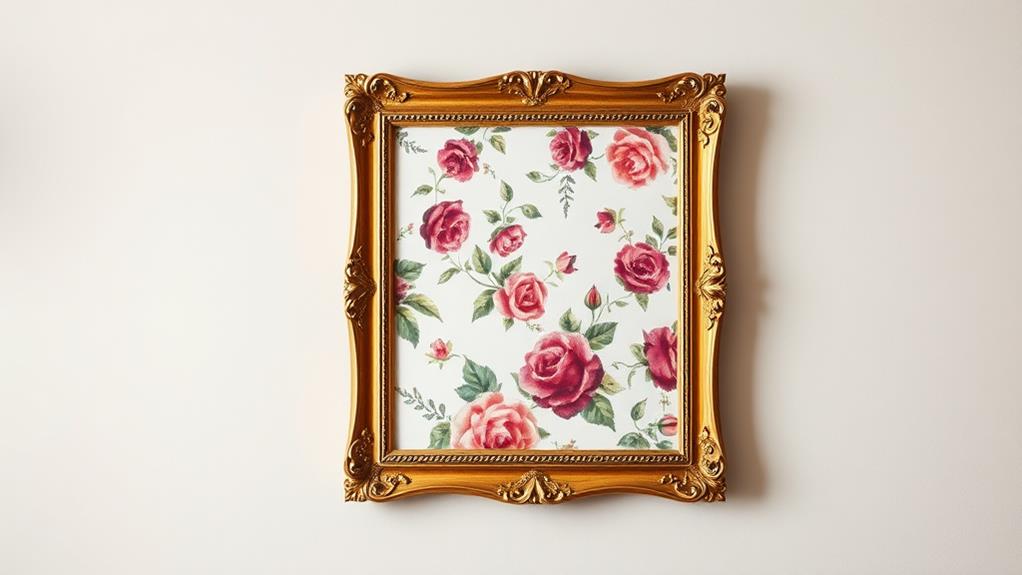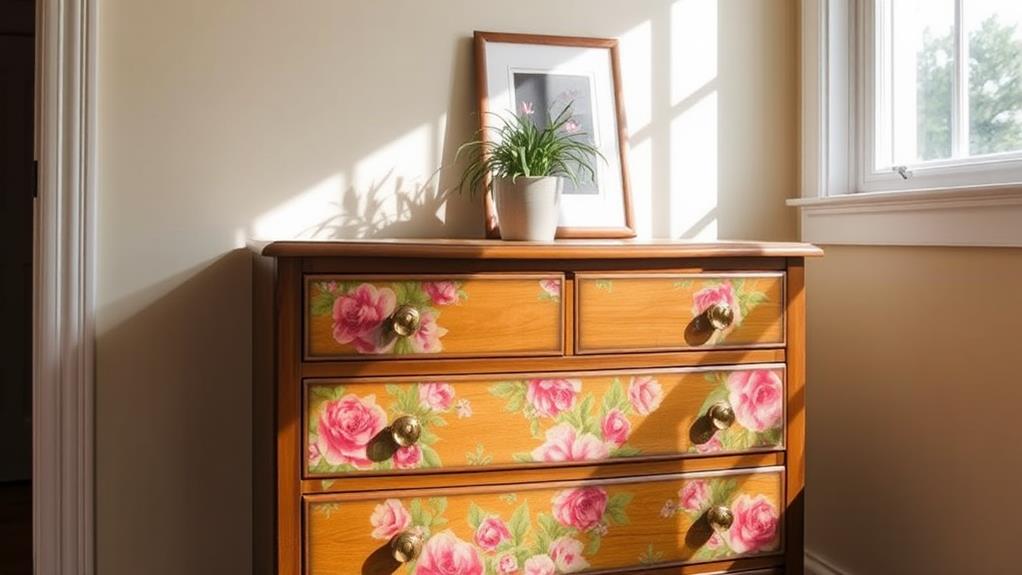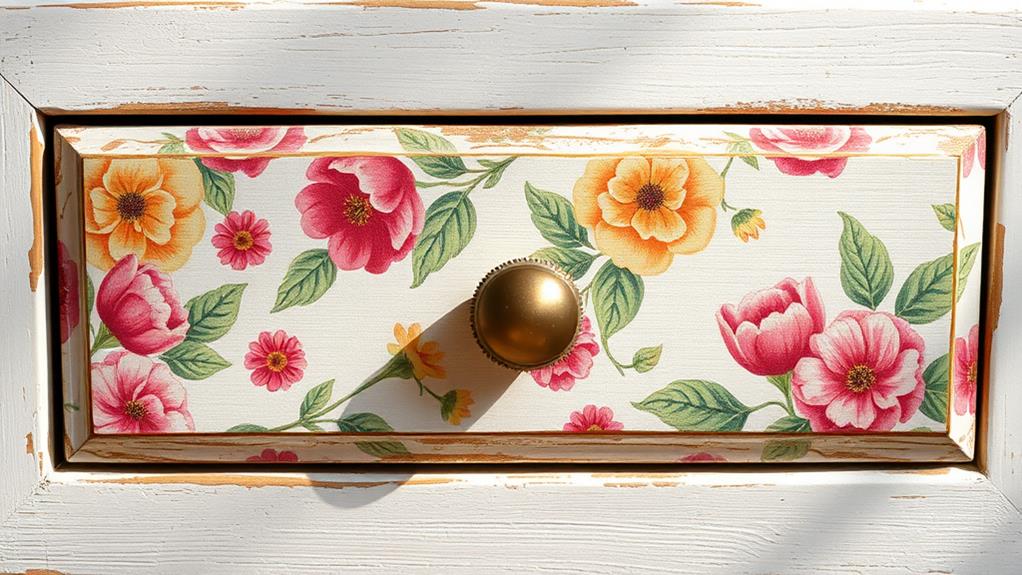Wallpaper remnants and samples offer endless possibilities for creative home decor. From framed art and accent walls to furniture facelifts and bookshelf backdrops, these versatile pieces can transform any space. Breathe new life into drawers and cabinets, or elevate storage solutions with patterned wallpaper. Even ceilings can become unexpected focal points with careful application. Whether you prefer bold geometric designs or subtle floral patterns, wallpaper remnants allow for personalized, high-impact decor without breaking the bank. By mixing and matching complementary colors and patterns, you can create a cohesive look throughout your home. Discover how these small pieces of wallpaper can make a big statement in your interior design.
Framed Wallpaper Art

Three innovative approaches to framed wallpaper art can transform your living spaces. The first method involves creating a gallery wall using various sizes of framed wallpaper samples. Choose complementary patterns and colors to create a cohesive look, or mix contrasting styles for a bold statement. Arrange the frames in a symmetrical or asymmetrical layout to suit your aesthetic preferences.
The second approach focuses on large-scale impact. Frame a single, oversized piece of wallpaper to serve as a striking focal point in a room. This technique works particularly well with intricate patterns or scenic designs, effectively creating a bespoke piece of art at a fraction of the cost of traditional artwork.
Lastly, consider using wallpaper remnants to create three-dimensional art pieces. Cut out individual motifs from the wallpaper and layer them within a shadowbox frame to add depth and visual interest. This technique is especially effective with floral or geometric patterns, allowing you to create a unique, textured artwork that adds dimension to your walls. By repurposing wallpaper samples and remnants, you can craft personalized, eye-catching decor that reflects your style and creativity.
Accent Wall Magic
While framed wallpaper art offers a versatile approach to wall decoration, accent walls provide a bold and transformative solution for those seeking to make a dramatic statement in their living spaces. Utilizing wallpaper remnants or samples for an accent wall can instantly elevate a room's ambiance without the commitment or expense of covering all walls.
When selecting a wall for this treatment, consider the room's focal point or architectural features. Headboard walls in bedrooms, fireplace surrounds in living rooms, or the wall behind a dining room table are prime candidates. Choose a wallpaper design that complements your existing decor while adding visual interest through color, pattern, or texture.
For a cohesive look, pull colors from the wallpaper into other elements of the room, such as throw pillows, artwork, or window treatments. If using multiple wallpaper samples, create a patchwork effect by arranging them in a grid or asymmetrical pattern. This approach not only maximizes the use of smaller pieces but also creates a unique, custom design. Ensure proper installation techniques to achieve a polished, professional finish that will stand the test of time.
Furniture Facelift

Tired furniture pieces can be given new life through the creative application of wallpaper. This technique offers an affordable and customizable way to revitalize outdated or worn items. Start by selecting a wallpaper design that complements your room's aesthetic and the furniture piece's style.
For wooden dressers or side tables, consider applying wallpaper to drawer fronts or tabletops. Ensure the surface is clean, smooth, and primed before adhering the wallpaper.
For larger pieces like armoires or bookcases, wallpaper can be applied to the back panels, creating an eye-catching display. Wallpaper remnants are perfect for smaller projects, such as lining the inside of drawers or covering lamp shades.
When working with intricate patterns, pay attention to alignment and matching across seams. Use a sharp utility knife for precise cuts around hardware or edges.
To protect your newly wallpapered furniture, apply a clear sealant or decoupage medium. This will increase durability and make cleaning easier. Remember that wallpaper can be removed or replaced in the future, allowing for ongoing style updates without purchasing new furniture.
Bookshelf Backdrops
Bookshelves' often overlooked backs present a prime opportunity for design innovation using wallpaper. By applying wallpaper remnants or samples to the rear panels of bookcases, you can transform these storage units into eye-catching focal points. This technique adds depth, color, and texture to your space while enhancing the visual appeal of your book collection.
Choose a wallpaper pattern that complements your room's decor and the books' spines. Bold geometric designs can create a modern, dynamic look, while subtle textures or nature-inspired patterns offer a more understated elegance. For a cohesive appearance, select colors that harmonize with your existing color scheme.
Before application, ensure the bookshelf's back panel is clean and smooth. Cut the wallpaper to size, leaving a slight overhang for trimming. Use removable wallpaper adhesive for easy future changes. For built-in shelves, consider using peel-and-stick wallpaper for simpler installation.
This design trick works particularly well in open shelving units, allowing the wallpaper to peek through gaps between books and decorative objects. It can also revitalize old or worn bookshelves, giving them a fresh, custom look without the need for extensive refurbishment or replacement.
Drawer and Cabinet Makeovers

Revamping drawers and cabinets with wallpaper can breathe new life into tired furniture pieces. This cost-effective technique allows for personalization and style enhancement without the need for extensive renovations. Begin by selecting wallpaper patterns that complement your existing decor or create a striking contrast for visual interest.
For drawer makeovers, measure and cut wallpaper to fit the drawer fronts precisely. Clean the surface thoroughly and apply wallpaper adhesive or opt for peel-and-stick varieties for easier application. Smooth out any air bubbles and trim excess paper for a polished look. Consider lining the interior of drawers with complementary or contrasting patterns for an unexpected pop of color when opened.
Cabinet transformations follow a similar process, with wallpaper applied to door panels or the entire cabinet face. For glass-front cabinets, apply wallpaper to the back panel to create depth and intrigue. To protect your newly wallpapered surfaces, apply a clear sealant or consider using washable wallpaper for high-traffic areas. This simple yet impactful technique can revitalize outdated furniture, add character to plain pieces, and create cohesion within your overall design scheme.
Stylish Storage Solutions
Building upon the concept of revitalizing furniture with wallpaper, stylish storage solutions offer another avenue for enhancing both form and function in your living spaces. Wallpaper remnants and samples can transform ordinary storage containers into eye-catching organizational tools. Covering plain cardboard boxes with patterned wallpaper creates chic, stackable storage for closets or shelves.
Similarly, decorating wooden crates with bold prints turns them into statement pieces for displaying books or collectibles. For a cohesive look, apply coordinating wallpaper patterns to different-sized storage bins, creating a unified set for various organizational needs. Repurpose old file cabinets by covering drawer fronts with textured wallpaper, instantly modernizing their appearance while maintaining functionality.
In the kitchen, line the inside of glass-front cabinets with colorful wallpaper to add visual interest and conceal items. For a subtle touch, use wallpaper to line desk drawers or the backs of bookshelves, providing unexpected pops of color and pattern. These stylish storage solutions not only maximize space but also contribute to the overall aesthetic of your home, turning mundane organizational items into design elements that complement your decor.
Unexpected Ceiling Transformations

Often overlooked, ceilings present a unique canvas for unexpected transformations using wallpaper. By applying remnants or samples to this often-neglected surface, homeowners can create a dramatic focal point that elevates the entire room. This technique works particularly well in smaller spaces, such as powder rooms or entryways, where it adds visual interest without overwhelming the area.
For a subtle effect, consider using textured wallpaper in a neutral tone that complements the wall color. This approach adds depth and dimension without dominating the space. Alternatively, bold patterns or vibrant colors can create a striking contrast, drawing the eye upward and making the room feel larger. Geometric designs can add a modern touch, while floral patterns bring a touch of nature indoors.
When applying wallpaper to ceilings, proper preparation is crucial. Ensure the surface is clean, smooth, and primed. For textured ceilings, it may be necessary to apply a thin layer of joint compound to create a flat surface. Use a high-quality adhesive and consider enlisting professional help for precise application, especially with intricate patterns or in rooms with challenging angles.
Frequently Asked Questions
How Do I Remove Wallpaper Remnants Without Damaging the Underlying Surface?
To remove wallpaper remnants without damaging the surface beneath, start by scoring the paper, then apply a wallpaper removal solution. After soaking, gently scrape off remnants using a putty knife. Clean the surface thoroughly afterward to remove any residue.
Can Wallpaper Samples Be Used in Bathrooms or High-Humidity Areas?
Did you know that 74% of homeowners prefer wallpaper in bathrooms for a luxurious feel? Wallpaper samples can be used in high-humidity areas, but it's crucial to choose moisture-resistant options and properly seal them to prevent peeling or mold growth.
What Adhesives Work Best for Applying Wallpaper Remnants to Different Surfaces?
For applying wallpaper remnants, choosing the right adhesive depends on the surface. Generally, wheat paste works well for porous surfaces, while vinyl adhesive is suitable for non-porous surfaces. Pre-mixed adhesives offer convenience, but always follow manufacturer recommendations for best results.
How Long Do Wallpaper Remnants Typically Last When Used for DIY Projects?
The longevity of wallpaper remnants in DIY projects varies depending on usage, surface preparation, and environmental conditions. When properly applied and maintained, they can last several years. Regular care and protection from moisture can extend their lifespan significantly.
Are There Eco-Friendly or Sustainable Options for Wallpaper Remnants and Samples?
Yes, eco-friendly and sustainable options for wallpaper remnants and samples are available. Many manufacturers now offer products made from recycled materials, organic fibers, or sustainably sourced resources. Look for certifications like FSC or Greenguard when selecting environmentally conscious wallpaper options.
Conclusion
In conclusion, the creative repurposing of wallpaper remnants and samples offers a wealth of design possibilities. From framed art to ceiling transformations, these versatile materials breathe new life into living spaces. Like a chameleon adapting to its surroundings, wallpaper can be tailored to suit any aesthetic vision. By embracing these innovative techniques, homeowners can achieve high-impact decor without breaking the bank. Ultimately, wallpaper wizardry demonstrates that with imagination and resourcefulness, even small scraps can yield grand results.

